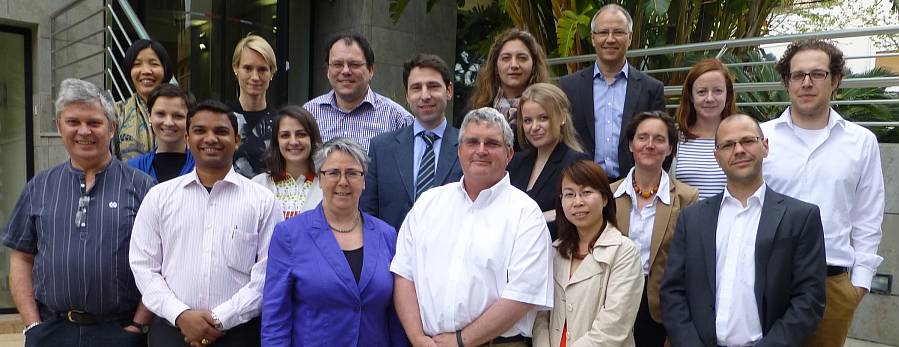Sustainability
OEKO-TEX® training more auditors for STeP certification

In the first week of April 2014 in Palma de Mallorca, Spain, 11 more OEKO-TEX® experts from North and South America, Europe, Asia and Australia were trained as STeP auditors in all matters concerning STeP. By deploying technicians and engineers from OEKO-TEX® institutes and their offices throughout the world for this demanding training, members of the International OEKO-TEX® Association vouch for the high value placed on sustainability in textile production.
Guided by OEKO-TEX® Association trainers, the prospective auditors successfully completed a four-day training programme, working through the six STeP certification modules with the help of practical examples. The information they swapped on their different cultural backgrounds and on the current state of the textile industry in their home countries of Cambodia, China, India, Australia, USA, Brazil, Italy, France and Germany additionally enriched the workshop for participants.
The training sessions emphasised independence, neutrality and uniformity in the assessment of production processes in the textile chain. Other key training content involved working with the STeP Assessment Tool on a daily basis and creating checklists for audits, as well as drawing up test reports as a prerequisite for a uniform approach. To ensure this in practice as well, auditors who had not yet done field work for companies were accompanied and guided by an experienced colleague.
STeP Modules
Consistency in the different auditors' assessments of gradation in the individual STeP modules is especially important. They must clearly recognise and distinguish between:
- unacceptable results/conditions (no-gos)
- minimum requirements in Level 1, but which already exceed national legal requirements
- higher STeP requirements in Level 2 (average European level)
- implementation of Best Available Techniques and modern management techniques in Level 3
Since STeP certification can assimilate other, already existing management systems for cost saving at companies, various management systems were presented and commonalities worked out. In particular these include ISO 9001 (quality), 14001 (environment), OHSAS 18001 (occupational safety) and SA 8000 (social responsibility). Using company policy and existing indicators as a basis, the auditors learned how to check the efficiency of management systems by asking simple questions.
Quality Management
The Quality Management module has been known for several years as OEKO-TEX® Assurance Audit. As such it is performed every three years in support of OEKO-TEX® compliant implementation within businesses for product-related OEKO-TEX® Standard 100 certification. Any internal provisions that company management establishes for the QM system can also count toward SteP certification.
Chemical Management
OEKO-TEX® auditor training also includes instructions on how to build up an optimum management system for chemicals alongside their unique CAS number identification, and how businesses can efficiently implement it into routine production. Auditors will then be able to perform a targeted check of how the chemicals are applied and to carry out proper inspections, for instance with regard to compliance with various Restricted Substances Lists (RSL). Chemical management not only includes extremely hazardous, polluting substances, but also products such as machine oils and detergents and soaps. The objectives for STeP certification are again graded: all chemicals are logged in Level 1, in Level 2 they are logged and assessed, and in Level 3 problem chemicals are replaced by harmless ones on an ongoing basis. This covers, on the one hand, the human-ecological requirements made on OEKO-TEX® tested textiles, and on the other, implementation of a management system that replaces environmentally-damaging chemicals.
Environmental Performance and Environmental Management
In the two modules on environmental performance of production processes, auditors learned all environmentally-relevant factors to successfully identify critical points at all stages of production. Among the topics covered were safe handling and storage of chemicals, efficient use of energy sources (electricity, gas, heating oil, etc.) and water, treatment of wastewater and its discharge into public bodies of water or water treatment plants, and emissions from boiler and production facilities. A further aspect in this context was compliance with the limit values required by STeP by OEKO-TEX® and the related grading into Levels 1, 2 and 3. Another issue involved the ecological treatment of (critical) waste and the functionality of waste control, as well as the potential effects of any accidents on the environment. Implementation of Best Available Techniques (BAT) for resources, equipment and processes was also discussed at length. What counts in the end for companies is not only to make external costs transparent, but to actively lower consumption in all environmental spheres. This commitment is, in turn, positively reflected in the assessment.
Social Responsibility
Using practical examples from the textile industry, auditors learned how different the social conditions at production plants can be, how complex the social aspects of audits are, which points must be paid special attention, and how to deal with difficult situations. This subject area especially pointed out that reasonable remuneration and proper working conditions must inevitably be reflected in the pricing of the product itself.
Occupational Health and Safety
Depending on the processing step, production plants must take into account specific challenges relating to occupational health and safety. They must provide for personal protective equipment (PPE) and designate working areas and production facilities with appropriate warning symbols. Other considerations such as optimum lighting at the workplace, checking safety measures for accident prevention, and competent servicing and suitability tests of facilities and machines were also broached. Equally important at all processing stages, however, is appropriate signposting of emergency exits and the posting of escape plans, as well as correct behaviour of staff in the event of emergency.
